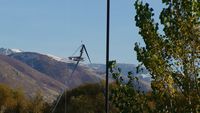 For the past several weeks, the Spaceward Foundation has been actively working to set up next year’s Space Elevator Games. As with the previous games, the goals in the Climber / Power-Beaming competition continue to get more ambitious. Two major changes for the 2008 Games are:
For the past several weeks, the Spaceward Foundation has been actively working to set up next year’s Space Elevator Games. As with the previous games, the goals in the Climber / Power-Beaming competition continue to get more ambitious. Two major changes for the 2008 Games are:
- The climb will now be 1 kilometer (10 times what was required in the 2007 Games).
- There will now be two levels of prizes: $900,000 (for a climb averaging 2m/s and $1,100,000 for a climb averaging 5 m/s).
The magnitude-sized increase in the length of the Power-Beaming climb will now almost certainly mean that only laser-powered entries will be able to successfully compete. We only had two such entries, USST and Lasermotive, in the just-completed games.
One of the reasons why only two teams took this route this year is that Lasers are EXPENSIVE – just ask those teams that used them in the last competition (or looked at them and reluctantly went to some other power source because they couldn’t afford them). And a laser that will power a climber a full Kilometer will have to be much more powerful than the ones used for the 100 meter climb this year – and that means even more expensive.
Spaceward has been talking with several different laser manufacturers to see if they would support the competition. At least two companies, TRUMPF and DILAS, have responded. This is from an email sent out earlier this week from Spaceward’s Ben Shelef:
“TRUMPF’s involvement is now official. They will support up to 4 groups with a laser on-site, plus testing at their factories. This is not strictly on a first-come basis, but we’re going to start forming these relationships now. This setup is capable of generating a 40 cm spot size, and the wavelength is 1040 nm. I want to stress (yet again) that they provide the light source delivered through an optical fiber – you have to build the rest of the optics. Also, travel and shipping, insurance, etc – this is not an all-expenses paid environment.
DILAS is offering an aggregeatable module system for sale which includes a light source and collimating optics and projects a 1 meter diameter spot at distances of up to 1 km. This is a different concept – you buy it and take it home with you. The cost is $10-12 per watt, and comes in 2500 Watt modules. We are allowing these modules to be shared as well. DILAS can supply a variety of wavelengths between 800 and 980nm.
From Spaceward’s point of view, this is a very good scenario – at least two viable and technically different baseline options.”
This should advance the technology even more quickly as it should allow multiple teams to create a laser-powered entry.
I looked at the web sites for both TRUMPF and DILAS. The TRUMPF site mentions it’s Laser Community, a magazine it produces devoted to the laser field. In the current issue, they make the following statement on the last page of the magazine: “100,000 Kilometers – Across this distance, laser beams may one day power the motors of the so-called Space Elevator. For now, this way from the Earth to Outer Space is still a technical dream. If and when it is ever realized is written in the stars.” Sounds like these guys ‘get it’.
As noted earlier, there will be two levels of prizes, one of $900,000 for team(s) meeting or exceeding 2 m/s and one of $1,100,000 for team(s) meeting or exceeding 5 m/s. This means that a prize purse of two MILLION dollars will be available for this competition. There will also be cash prizes awarded for teams that average at least 1 m/s for the Kilometer-length climb – these prizes will be taken out of the two million dollar purse.
The formula for awarding these prizes, as well as all of the other proposed rules for the 2008 competition, are contained in the preliminary rulebook available here.
Next up – how and where do you set up a 1 Kilometer raceway?

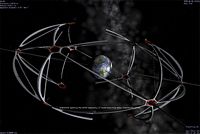
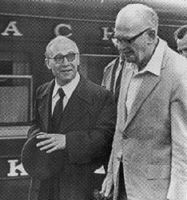
 Yesterday, Dr. David Livingston of The Space Show interviewed Dr. Bradley Edwards and Ms. Carla Sabotta.
Yesterday, Dr. David Livingston of The Space Show interviewed Dr. Bradley Edwards and Ms. Carla Sabotta.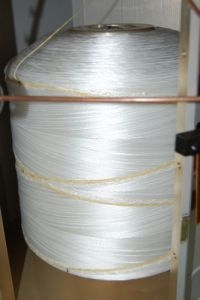 In April of this year, I posted about a couple of tether launches scheduled for later in the year. One was from Tethers Unlimited, home of the esteemed Robert Hoyt (documented
In April of this year, I posted about a couple of tether launches scheduled for later in the year. One was from Tethers Unlimited, home of the esteemed Robert Hoyt (documented  Since the competition, LaserMotive has put up a number of posts on their blog. These cover everything from who some of their sponsors / suppliers were, to qualifying videos to problems with their brakes, etc. Rather than trying to summarize each one, just go visit their blog,
Since the competition, LaserMotive has put up a number of posts on their blog. These cover everything from who some of their sponsors / suppliers were, to qualifying videos to problems with their brakes, etc. Rather than trying to summarize each one, just go visit their blog,  Yes the Games are over and yes I’m sure that 99% of the readers here already know the results. But I did a search on the various articles written in a “wrap-up mode” and am posting some of them here. All of them (IMHO) contain some info I didn’t know or were , in other ways interesting…
Yes the Games are over and yes I’m sure that 99% of the readers here already know the results. But I did a search on the various articles written in a “wrap-up mode” and am posting some of them here. All of them (IMHO) contain some info I didn’t know or were , in other ways interesting…









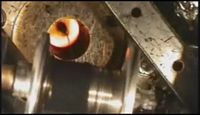
 Brian Turner, captain of the Kansas City Space Pirates, sent me
Brian Turner, captain of the Kansas City Space Pirates, sent me 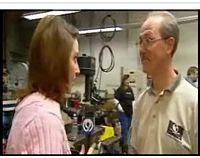
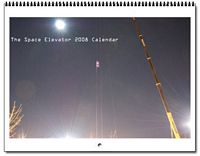
 I have four more videos and two more pictures to post to complete my coverage of the 2007 Light Racers Competition.
I have four more videos and two more pictures to post to complete my coverage of the 2007 Light Racers Competition.











 As most of my readers know, Ken Davidian is NASA’s program manager for the
As most of my readers know, Ken Davidian is NASA’s program manager for the 
 Brian Turner and the Kansas City Space Pirates today issued this Press Release:
Brian Turner and the Kansas City Space Pirates today issued this Press Release: I’m happy to report that the
I’m happy to report that the 






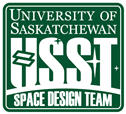 I’ve finally been able to upload the videos of the five runs that USST did on the last day of competition (Monday, October 22nd.) The first video shows a climb in the daylight. Therefore, you can’t actually see the laser-beam as my camcorder shot it in “normal” (i.e. not night) mode. But there is a nice sunset in the background to compensate 🙂
I’ve finally been able to upload the videos of the five runs that USST did on the last day of competition (Monday, October 22nd.) The first video shows a climb in the daylight. Therefore, you can’t actually see the laser-beam as my camcorder shot it in “normal” (i.e. not night) mode. But there is a nice sunset in the background to compensate 🙂
